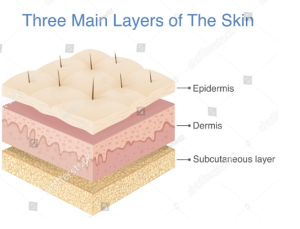CONDITIONS
Skin structure and Function
The skin is the largest sensory organ of the human body, consisting of various elements like water, protein, fats, and minerals.

Every inch of skin contains 19 million skin cells, 650 sweat glands, 20 blood vessels, and 1,000 nerve endings. The weight of your skin varies based on your height and body mass, ranging from 3.5 to 10 kilograms. It covers a surface area of about 1.5 to 2 square meters. The skin undergoes a process of renewal throughout your life by shedding old skin cells and generating new ones approximately every 28 days.
Anatomy
The structure of the skin is made up of three layers, namely: Epidermis, dermis, and hypodermis.
Epidermis: The visible and touchable outermost layer of your skin that acts as a barrier. It consists of skin cells that contain a protein called keratin. Keratin and other proteins bind the skin cells together to form this layer. Additionally, the epidermis contains melanin, the pigment responsible for skin, hair, and eye color. The amount of melanin determines the individual’s skin color, and those with more melanin tend to have darker skin. Langerhans cells, part of the body’s immune system, are also present in the epidermis. They help fight off germs and infections.
Dermis: Middle layer comprising sweat glands, hair follicles, connective tissues, blood vessels, and nerves. Blood vessels in the dermis nourish the epidermis, keeping the skin layers healthy. Nerves in the dermis detect sensations like heat, itchiness, and softness and help you feel pain. Hair follicles and sebaceous oil glands are present in the dermis. The oil glands produce sebum, which helps keep the skin soft and smooth. Sweat glands in the dermis release sweat through pores on the skin’s surface. Sweat aids in regulating body temperature.
Hypodermis: It is the innermost subcutaneous layer of the skin. It primarily consists of fat cells. The layer of fat acts as insulation, helping the body from getting too cold or hot. It cushions the internal organs, muscles, and bones and protects them from potential injuries or impacts.
Functions
- Protection: The skin acts as a physical barrier, protecting our internal organs, muscles, and bones from injury, infections, and harmful substances present in the environment.
- Sensation: The skin contains numerous nerve endings that allow us to sense and respond to stimuli such as touch, pressure, temperature, and pain.
- Regulation of body temperature: Sweat glands in the skin produce sweat, which evaporates and helps cool down the body when it gets too hot.
- Vitamin D synthesis: When exposed to sunlight, the skin plays a crucial role in producing vitamin D, essential for maintaining healthy bones and immune function.
- Excretion: Small amounts of waste products, such as water, salts, and certain toxins, are eliminated from the body through sweat glands in the skin.
- Immune defense: Specialized cells in the skin, such as Langerhans cells, fights off germs and infection.









